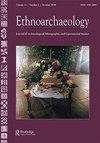Maya Potters’ Indigenous Knowledge: Cognition, Engagement, and Practice
IF 1.3
0 ARCHAEOLOGY
引用次数: 0
Abstract
more useful in frequency seriations for chronology. He also concludes that interpretations of activity patterns (e.g. estimates of where cooking occurred) are complicated by the fact that they “are the product of differences in [pottery] type use lives as much as they are the product of ancient pot-using behavior” (p 173). This is a very detailed study of an important issue in archaeology, but I suspect that only a few dedicated readers will need the level of detail presented, particularly in Chapter 6. I hope that archaeologists, especially those who work with pottery, will consider applying some of Shott’s findings to their pottery data and add comparative data to this case study and the others Shott discussed so thoroughly. This is a study of the minutia of archaeology, but the implications of research like this are important.玛雅·波特的本土知识:认知、参与与实践
在频率序列中更有用。他还得出结论,对活动模式的解释(例如,对烹饪发生地点的估计)是复杂的,因为它们“既是古代使用陶器行为的产物,也是[陶器]使用生活类型差异的产物”(第173页)。这是对考古学中一个重要问题的非常详细的研究,但我怀疑只有少数忠实的读者会需要这种程度的细节,特别是在第6章。我希望考古学家,尤其是那些研究陶器的考古学家,能考虑将肖特的一些发现应用到他们的陶器数据中,并在这个案例研究和肖特所深入讨论的其他案例中添加比较数据。这是一项关于考古细节的研究,但这类研究的意义很重要。
本文章由计算机程序翻译,如有差异,请以英文原文为准。
求助全文
约1分钟内获得全文
求助全文
来源期刊

Ethnoarchaeology
ARCHAEOLOGY-
CiteScore
1.60
自引率
0.00%
发文量
10
期刊介绍:
Ethnoarchaeology, a cross-cultural peer-reviewed journal, focuses on the present position, impact of, and future prospects of ethnoarchaeological and experimental studies approaches to anthropological research. The primary goal of this journal is to provide practitioners with an intellectual platform to showcase and appraise current research and theoretical and methodological directions for the 21st century. Although there has been an exponential increase in ethnoarchaeological and experimental research in the past thirty years, there is little that unifies or defines our subdiscipline. Ethnoarchaeology addresses this need, exploring what distinguishes ethnoarchaeological and experimental approaches, what methods connect practitioners, and what unique suite of research attributes we contribute to the better understanding of the human condition. In addition to research articles, the journal publishes book and other media reviews, periodic theme issues, and position statements by noted scholars.
 求助内容:
求助内容: 应助结果提醒方式:
应助结果提醒方式:


